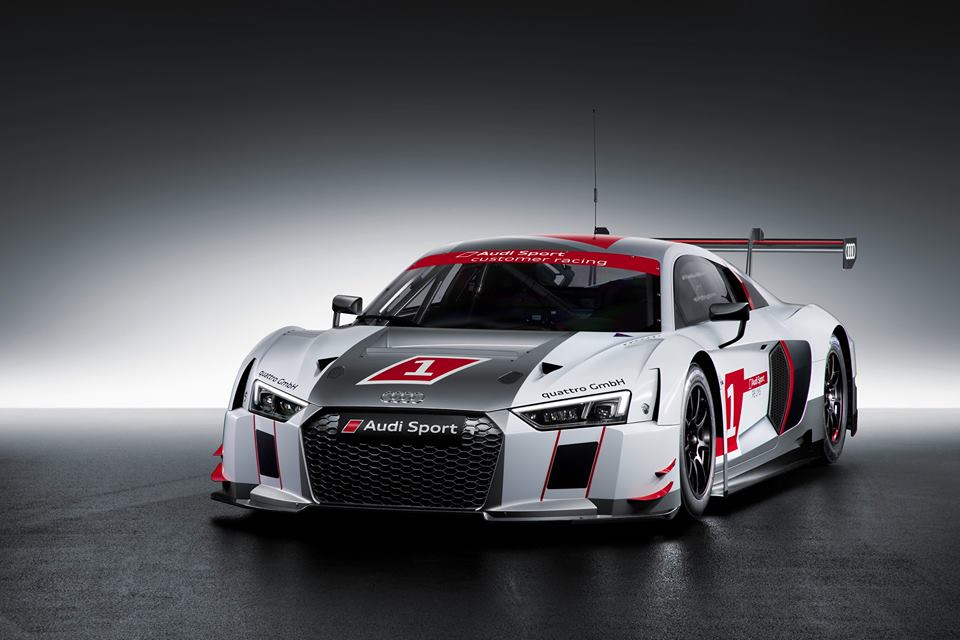There will be a more extensive Geneva Show update later – and a gallery later in the week from John Brooks – but for now here are a couple of images of the new for 2015 GT3 spec Audi R8 LMS just posted on Twitter by Audi Sport.
The headlines talk of a car ready for the forthcoming 20156 regulations, an R8 that is safer and lighter than before with more technology and improved aerodynamics.
The car commenced testing in the spring of 2014 ahead of a race programme this year, in the hands of partner teams, that will take in the 24 Hours of the Nurburgring and Spa (where we will no doubt see the new car race head to head with the current generation of R8 LMS ultra.
The new car will have considerably impressive shoes to fill, over 130 first generation R8 LMS cars were sold and between them scored 26 GT3 Championship wins between 2009 and 2014, plus 23 titles in other classifications and seven overall victories in 24-hour races.
Customer orders for the new car will follow in the second half of 2015 with the first deliveries to customer teams before the end of this year.
Safety
The new Audi R8 LMS surpasses the safety requirements of the regulations to be introduced in 2016.
Modified front end structure
CFRP crash element at the rear that is (used for the first time)
GT3 race car meets the LMP crash test requirements.
A quickly adjustable foot lever system and a height and length adjustable safety steering column.
A rescue opening in the roof as used in DTM is introduced in a GT3 race car for the first time. After an accident, it allows the driver’s helmet to be lifted in a way that avoids straining the spinal column.
The Audi Protection Seat PS 1 that will also be used in the R8 LMS in the future has been setting seating technology standards in the LMP class for years. It is connected to the chassis for increased stiffness.
Weight
Despite the additional weight resulting from the additional safety structures and systems the base weight of the race car has been reduced from 1,250 to 1,225 kilograms.
The chassis is 30 kilos lighter via use of an “intelligent material mix of aluminum in the Audi Space Frame (ASF), a structural CFRP component and the steel roll cage .”
Chassis structure now weighs just 252 kilograms.
Torsional stiffness of the stressed frame has increased by 39 percent.
Integration into road car production
Although the material mix in a race car is more complex, Audi has managed to integrate the manufacturing process for production and race cars even more closely than before. In a new manufacturing facility at the Böllinger Höfe industrial park in Heilbronn, quattro GmbH produces both variants in combination.
Although the race car, for example, is fitted with aluminum cast joints and a steel roll cage the racing chassis of the R8 LMS remains integrated in the basic production process up to and including the stages of roof assembly and cathodic dip painting (CDP), which is a form of priming. Following these production steps, the race cars are completed in Heilbronn-Biberach.
The 5.2 litre V10 engine with (power output of up to 430 kW (585 hp) )leaves the same line as the production unit. It remains nearly unchanged and, with a class leading scheduled rebuild interval of 20,000 kilometers.
Race Development
Modified or completely new assemblies have been included whenever this is required in racing by the regulations or by the clearly higher loads that occur in competitive conditions.
The production ASF chassis, for instance, is modified whereas the completely new bodywork is made of CFRP.
Suspensions now use wishbones strictly designed for racing for the first time and the six-speed transmission with paddle shifters is a completely new development as well.
It is significantly lighter than its predecessor while its efficiency has increased because the previous drop gear system has been eliminated.
The new MS 6.4 electronics include engine electronics, traction control and software for the electro-hydraulic gearshift. The powerful processor enables higher processing speeds that result in faster responses.
A power box is another new feature. It replaces the traditional fuse box and makes it possible to define individual loads and scenarios.
Aerodynamics
The new aerodynamic concept of the Audi R8 LMS for the first time includes a fully lined underfloor and a conceptually integrated rear diffusor.
As a result, the dimensions of the rear wing can be reduced without a corresponding increase of aerodynamic drag.
The wheel wells, which are open rearwards via a larger cross-section, contribute to improved airflow.
The airflow rate and cooling area of the radiator at the front have increased by ten percent to handle maximum outside air temperatures.
Fresh air circulation in the cockpit has been improved. At a speed of 200 km/h, the airflow rate is 250 liters per second.
Audi has achieved these improvements despite the significantly higher constraints imposed on aerodynamics design by the 2016 regulations.







